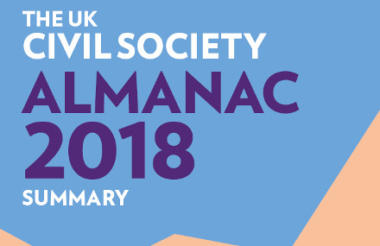The UK charity sector’s total income has grown by 4 per cent to £47.8bn, but smaller charities are “struggling”, according to NCVO’s UK Civil Society Almanac 2018 published today.
Total net assets have recovered to pre-recession levels, reaching £121.3bn this year and surpassing the previous high in 2007/08 of £120.5bn, leading NCVO to declare that the sector’s recession recovery is “complete”.
Assets, which are things like investments and cash, totalled £121.3bn in 2015/16, while liabilities such as loans and pension deficits came to £19.2bn.
The data is this year’s almanac relates to the financial year 2015/16, covering a period when there was intense media scrutiny over fundraising methods. All figures have been adjusted for inflation.
Income growth driven by individuals
The sector’s income rose by 4 per cent in 2015/16 – ahead of inflation which was less than 2 per cent during the same period.
This is the third successive year of growth, after two years in which income fell. In 2014/15, income grew by 2.7 per cent and the previous year it grew by 5.8 per cent.
Income from government sources declined slightly to £15.3bn. But income from members of the public increased by £1.5bn to £22.3bn and now represents 47 per cent of the sector’s total income – up from 45 per cent last year.
Growth of income from the public is split into two categories. Income in the form donations accounts for £10.9bn, and earned income through charitable or fundraising activity was £11.4bn – a growth of 8 per cent on the previous year.
Meanwhile the sector’s spending was £46.5bn. 85 per cent of spending is attributed to charitable activities or grantmaking.
The level of reserves increased by 5 per cent to £53bn.
The charity sector contributed £15.3bn, measured by gross value added, to the UK economy. This is similar to the GDP of Estonia.
‘Variation in experience on the ground’
However, the umbrella body warned that the recovery was uneven.
In 2013/14 NCVO introduced a new category the ‘super major charity’ for those with incomes over £100m. There are now 45 such charities – five more than when NCVO started tracking them.
Meanwhile, charities with an income of £1m or more made up 3 per cent of the sector but accounted for 80 per cent of the income.
Sir Stuart Etherington, chief executive of NCVO, said: “We can and should celebrate the fact that the UK voluntary sector continued to grow, doing more than ever for the people and causes it works for. But I know that aggregate numbers can disguise a great deal of variation in experience on the ground.
“While some charities are going from strength to strength, others, smaller charities in particular, are struggling with the ongoing local government spending squeeze, or being pushed out of an increasingly competitive public services market.
“Income from the public was strong in the year under examination, but many have suggested that the transition to a longer-term approach to fundraising methods and the impact of changes to data law could mean future fundraising returns will be lower in the short term.
“The sector as a whole may have recovered from the impact of the recession, but there is clearly no shortage of risks out there for charities. The solutions, as ever, all come back to ensuring organisations have the strong governance needed to help them manage risks and to ensure they grasp opportunities.”
NCVO uses data from a sample of thousands of charities’ annual accounts to produce the almanac.
Related articles











